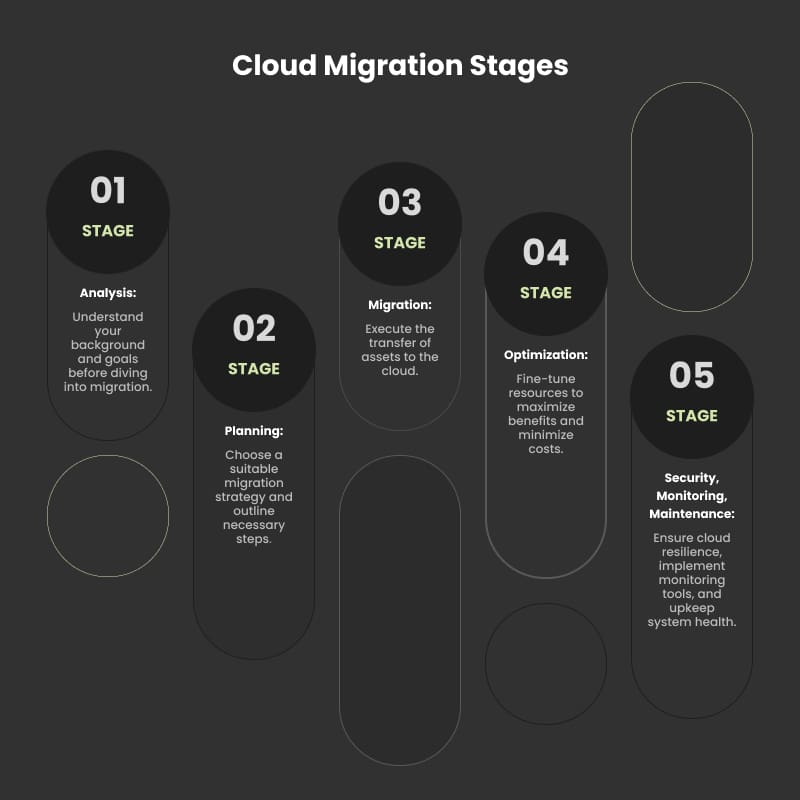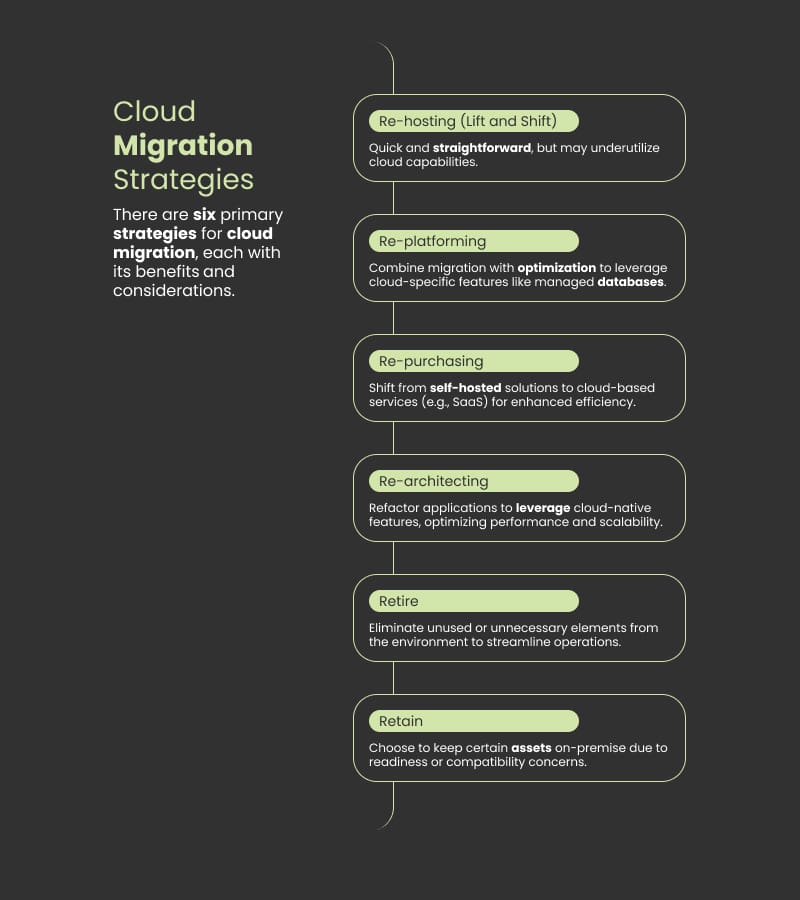Cloud migration is a process in which you move your digital assets from on-premise infrastructure to a cloud. What makes it even more complicated is that there’s no one-fit-all solution.
Therefore, a cloud migration strategy should fit the needs, capabilities, and limitations of a particular company operating in a certain business environment. But how to do that?
Cloud Migration Strategy – Why You Need One?
Consequently, to make the most out of the cloud migration, you need to choose and adjust a coherent strategy. Only then you will know which profits are most important for you and how to make it work in your favour.
Speaking of that, if you don’t know what are the benefits of cloud migration, I encourage you to check our previous article. It will provide you with reasons to consider cloud migration for your organization.
In this article, I will focus on the first stage of this process. It will lead you to the choice of the most suitable cloud migration strategy for your company. However, before doing so, let us briefly look at the whole process. It will give us the perspective.
What Are the Stages of Cloud Migration?
You can break down the process of cloud migration into 5 stages. They’re:
- Analysis – before you start doing anything, you should find out, what’s your background and what are your goals;
- Planning – now that you’ve done the analysis, let’s choose the cloud migration strategy and plan what needs to be done;
- Migration – do the job. Move your assets to the cloud;
- Optimization – adjust everything to gain the maximum benefit at minimal cost;
- Security, monitoring, and maintenance – make sure your cloud is breach-resistant, implement monitoring solutions, and keep your stuff in good condition.
As you can see, there are two salient stages before the migration itself takes place. Proper analysis and planning can save you loads of money and time spent otherwise spent on dealing with obstacles that could easily be predicted. Now let’s see what factors make effective analysis for the cloud migration.
Cloud Migration Strategies
There are six types of strategies for cloud migration. Typically, they are described as below. However, it doesn’t mean that they’re the only solutions. Your strategy should be in line with your needs and capabilities. Consider mixing these cloud migration strategies, so they give you the biggest value. Even more, you can apply various strategies to different elements of your environment.
- Re-hosting – also known as lift and shift, is a strategy, where you take all you have and simply move it from your on-premise hosting to the cloud of your choice. In theory, this solution is simple and quick and doesn’t need coding or architecture changes. However, it doesn’t take full advantage of cloud infrastructure and often is ineffective.
- Re-platforming – some say it’s Re-hosting plus Optimization. As the process of migration takes place, you also optimize your applications and other assets so that they fit the new infrastructure. For example, using cloud databases (like Amazon RDS) instead of maintaining a standalone database.
- Re-purchasing – this strategy is based on seizing to use your old services and moving to cloud-based services (e.g. SaaS). For example, you move from a self-run email system hosted on your on-premise infrastructure and move to a cloud-based SaaS email offering.
- Re-architecting – sometimes it’s hard to improve and scale-up with your current infrastructure. Then you should consider refactoring and re-architecting your solutions so that they meet new requirements, optimize maintenance costs, and improve performance and application quality, typically using cloud-native features. This approach is also called service-oriented (or serverless) approach.
- Retire – some elements of your environment can appear to have been unused or unnecessary. It may lead to a decision to turn them off and simply throw off the ballast.
- Retain – in case of some applications or assets, you may want to withdraw from migrating. Maybe your organization isn’t ready to change in this realm. Or you haven’t found a cloud solution that will fit your needs. In such cases, it’s advisable to do nothing and re-visit these assets in the future.

Analysis for Cloud Migration
Now we’ll look at things you need to analyse before you choose the cloud migration strategy so that it suits your needs. Below you’ll find 10 issues we in Inspeerity find particularly important.
1. DIY or Outsourcing
If you already have the Know-How and hire experts in your company, it might be reasonable to do it on your own. Otherwise, it will be quicker and cheaper to outsource the cloud migration project. Keep in mind that unskillful migration can possibly lead to higher expenses on application maintenance costs instead of saving you money.
2. Evaluation of IT environment
What infrastructure you use now, and what are your plans for future improvement and scaling up? What are the costs today, and how will they change depending on the chosen scenario.
3. Business Processes Mapping
When trying to improve the way your organization works and boost its efficacy, you should start with process mapping to learn how exactly your company works now. For example, it will help you identify the bottlenecks that stop your growth.
4. User needs analysis
Both the internal and external users should be evaluated here. You must take their needs into account when implementing new solutions. Usually, it means widening the range of services and functionalities.
5. Solutions and applications research
There are plenty of applications and digital products that enhance the cloud migration process. If you want to make the right choice and mix them into a tailor-made solution, you’ll need a thorough market research.
6. Amount of changes designation
Will you need code refactoring in your applications or change in the architecture of your current solutions due to the migration? They might be perfect for your on-premise infrastructure, but won’t be as efficient on the cloud. Then you should consider some adjustments, that will help you get the benefits of migrations.
7. Choice from four types of cloud services
There are four main types of services available on the cloud market. Each of them is good for a different purpose. Evaluate your needs and choose accordingly.
- PaaS (Platform as a Service) – you can develop, run, and manage applications on the cloud platform (infrastructure, operating system, development tools, etc.) of your provider.
- IaaS (Infrastructure as a Service) – in this model, you gain access to (almost) pure infrastructure. You need to do more on your own, but also have more flexibility. SaaS (Software as a Service) – here you get access to a specific application. You can’t and don’t need to delve into technical details.
- FaaS (Function as a Service) – with this service, you (or your developers) can focus on creating and delivering a particular function to your users, without taking care of the infrastructure.
Migrating an application you should decompose it, so each element uses the kind of service it needs. Sometimes, especially when you don’t have IT experts in your team, it’s better to pay your cloud provider for maintenance and support.
8. Risk analysis and rollback procedure
What are the possible risks, and what’s the probability that they occur? Moreover, is it better to prevent their occurrence or to have a back-up plan?
9. Cost estimation
Before you make the final decision, you need to check your figures. Remember that migration is supposed to lower your costs and increase your agility and efficiency.
10. Legal limitations
Are you bound by any legal regulations? Do they prevent you from cloud migration or imply any particular solutions? Think about GDPR, financial regulations, etc. Are there any procedures that need to be adjusted to cloud computing?
Thorough consideration of these issues will give you sufficient background to choose the right strategy and start planning your migration. By this time, you might wonder if you’re capable of conducting such an analysis. The good news is that, although it’s a complex process, you can delegate it to a company like Inspeerity. Our experts will evaluate your situation and advise on the nuances of cloud migration.
What’s Next?
The next stage in the process of cloud migration is the planning. But how to plan the migration? What are the substages in planning? Well, it depends on the strategy you choose. You will get to know the most common cloud migration strategies from our article: 6 Cloud Migration Strategies: How To Choose the Proper One?
Would you like to consult your cloud migration plans?
Our team is ready to help you.
Q: What is cloud migration?
Cloud migration is the process of moving digital assets from on-premise infrastructure to a cloud.
Q: Why do I need a cloud migration strategy?
A cloud migration strategy is important because it helps to choose and adjust a coherent plan that fits the needs, capabilities, and limitations of a particular company operating in a certain business environment.
Q: Can I mix different cloud migration strategies?
Yes, it is possible to mix different cloud migration strategies in order to gain the biggest value for your organization. Different strategies can also be applied to different elements of your environment.
Q: What are the different types of cloud migration strategies?
The different types of cloud migration strategies include: Re-hosting, Re-platforming, Re-purchasing, Re-architecting and Retire. Each strategy has its own advantages and limitations and should be chosen based on the needs and capabilities of the organization.





